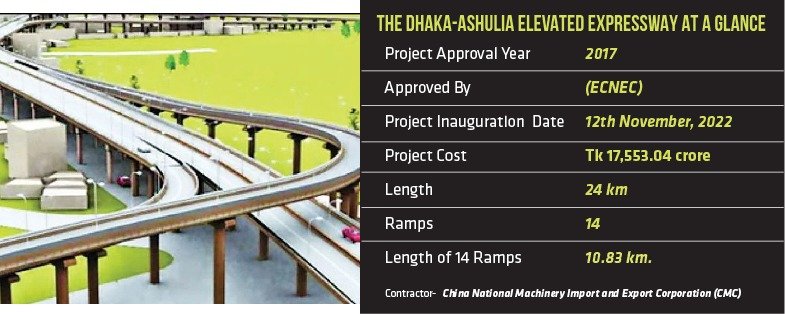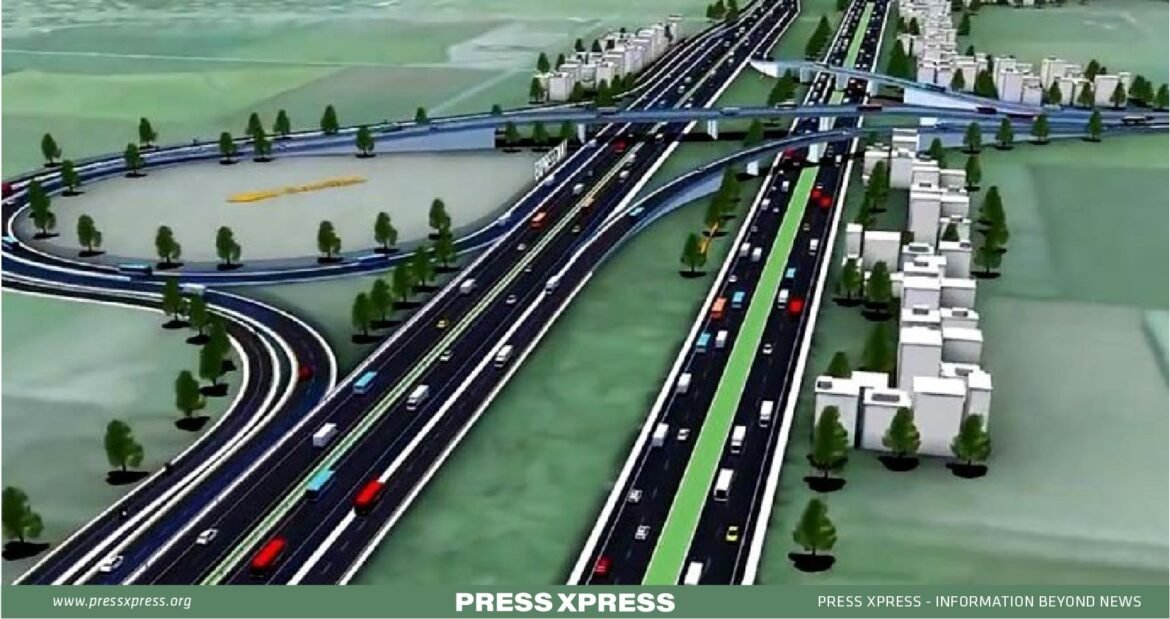The Dhaka-Ashulia Elevated Expressway is a groundbreaking initiative addressing Dhaka city’s traffic congestion. As a significant infrastructure project in Bangladesh, it holds the promise of delivering essential relief to commuters. Commencing construction on November 12 of the previous year, it has already achieved notable progress, advancing at a rate of 9.5% annually. The project is projected to reach completion in the next three years, covering a distance of 44 km and connecting to the Dhaka Elevated Expressway, offering a direct route from Jatrabari to Bypile.
You can also read: Bridging the Future: Infrastructure Development in Bangladesh
To combat traffic issues in the capital, the government is executing various measures, including flyover construction, the launch of the Metrorail system, and the ongoing subway project. However, the most anticipated development for Dhaka’s residents is the elevated expressway project, which has the potential to provide long-lasting relief. Simultaneously, work is underway on two other expressways, with one segment already operational. The successful completion of these endeavors is expected to not only enhance Dhaka’s quality of life but also revolutionize the transportation of export goods, boosting the Gross Domestic Product (GDP).
Prime Minister Sheikh Hasina recently inaugurated the nation’s first elevated expressway, a crucial step in easing Dhaka’s traffic woes. Stretching from Hazrat Shahjalal International Airport to Farmgate, this flyover officially opened for vehicular traffic on September 2.
Project Details and Estimated Cost
The Dhaka-Ashulia Elevated Expressway Project in Bangladesh, which is under the supervision of the China National Machinery Import and Export Corporation (CMC), was included in the Memorandum of Understanding outlining significant cooperation initiatives between the Chinese and Bangladeshi governments. This project has been a major focal point for both governments and represents a significant development in the realm of transportation infrastructure in Bangladesh over recent years.
The Dhaka-Ashulia Elevated Expressway is originally 24 kilometers long and features 14 ramps, extending 10.83 kilometers. The project also includes a 1.95-kilometer flyover at Nabinagar and a 2.72-kilometer bridge at Ashulia-Dhaur embankment, eliminating dams in Ashulia Bill and improving water flow in Turag River and Bill. The project encompasses 14.28 kilometers of road and 18 kilometers of drainage duct.

The Dhaka-Ashulia Elevated Expressway is under the supervision of the Bangladesh Bridge Authority and received approval from the Executive Committee of the National Economic Council (ECNEC) in 2017. The project carries a budget of Tk 17,553.04 crore and is scheduled for completion by June 2026. Prime Minister Sheikh Hasina inaugurated the project on November 12 of the previous year.
Upon completion, the Dhaka-Ashulia Elevated Expressway will have a far-reaching impact on transportation in Bangladesh. It will directly link to the Asian Highway, providing improved inter-country road communication. This project will connect major highways like Dhaka-Chittagong, Dhaka-Sylhet, Dhaka-Mymensingh, Dhaka-Jamalpur, Dhaka-Manikganj-Tentulia, and Dhaka-Mawa-Barisal, significantly enhancing the country’s infrastructure. Toll rates will be implemented for all vehicles using the flyover.
Construction Progress
Recent observations show substantial development, including numerous piers in the Ashulia Embankment area and the completion of some pier caps. Progress can also be noted along the road from Abdullahpur to Dhaur. While the percentage of construction completion lags behind, it is clear that the project is moving forward.
As of the 11th of this month, 1,261 piles for the Dhaka-Ashulia Elevated Expressway have been successfully installed. Additionally, 95 pile caps and beams have been completed, along with 48 pier columns.
Challenges on the Horizon
Despite the promising progress, there are numerous challenges that the project faces:
Service Lines and Electric Cables:
One of the most significant challenges the project faces is the presence of service lines from various utility companies within the project area. These lines must be relocated to avoid potential risks. However, the process has been plagued with difficulties, and the removal of electric cables is particularly challenging. Shutting down electricity during construction is not feasible, making it hard to work around these obstacles.
The Road’s Geometry:
Elevated expressways need to be straight to facilitate high-speed travel. Unfortunately, the route chosen for the Dhaka-Ashulia Expressway is quite curvy, which necessitates adjustments to meet the expressway’s standards. This challenge requires additional effort to ensure a smooth and efficient road for commuters.
Delays in Land Acquisition:
The project authority has encountered difficulties in securing the necessary land for the expressway’s construction. This issue has resulted in delays, making it imperative to address land acquisition concerns to keep the project on track.
Connecting Bypass Roads:
Maintaining traffic flow during construction is a top priority. To this end, bypass roads are being developed to ensure that commuters can navigate the construction areas with minimal disruptions, further adding to the complexity of the project.
Expert Opinion
In this context, Communication expert and Bangladesh University of Engineering and Technology (BUET) professor Hadiuzzaman highlights the transformative potential of this project. When the expressway connects Qutubkhali to Bypile, it will enable heavy vehicles to bypass Dhaka entirely, 24 hours a day, relieving the congested roads below. This will create space for improved public transport, but the benefits may not be fully realized until 2026-27
Conclusion
The Dhaka-Ashulia Elevated Expressway will mark a significant milestone in the ongoing efforts to alleviate traffic congestion in Dhaka, the capital city of Bangladesh. With the rapid urbanization and increasing vehicular traffic, this project is a beacon of hope for residents and commuters. Not only will it provide much-needed relief for those navigating the bustling city, but it also holds the potential to transform the transportation landscape of the entire nation. The elevated expressway’s strategic connections and its role in improving inter-country road communication are pivotal to Bangladesh’s future development. The completion of this ambitious infrastructure project promises to be a game-changer for the region, offering enhanced economic growth and a higher quality of life for the people of Bangladesh.


